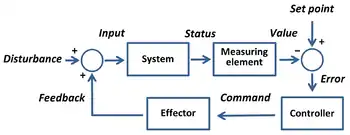目標值
目標值(target)也稱為設定值(setpoint,簡稱SP)或參考值(reference),是模控學及控制理论中的名詞,是指系統想要達到的狀態[1],常用來描述系統標準的組態[2]。變數相對其目標值的偏離量是以誤差為準的控制系統的基礎[3],會利用回授的方式使系統回到其穩態。例如一個鍋爐有其溫度設定值,也就是鍋爐控制系統希望鍋爐維持的溫度。

負回授系統的方塊圖,利用誤差控制系統在目標值附近。正誤差表示回授過低,控制器會增加輸出,負誤差表示回授過高,控制器會減少輸出
在控制系統中,目標值是受控程序變數(PV)的目標值,系統會持續的將實際程序變數和目標值比較,系統會將目標值和實際程序變數相減,所得的即為誤差訊號。若以數學表示,其誤差訊號如下:
是特定時間的誤差,是目標值,是 特定時間的程序變數。
控制器會利用誤差訊號來調整控制輸出,使程序變數儘量接近目標值,同時維持系統的穩定,並且讓過衝降到最低。
參考資料
- An 'essential variable' is defined as "a variable that has to be kept within assigned limits to achieve a particular goal": Jan Achterbergh, Dirk Vriens. . . Springer Science & Business Media. 2010: 47. ISBN 9783642143168.
- B. Wayne Bequette. . Prentice Hall Professional. 2003: 5. ISBN 9780133536409.
- W. Ross Ashby. . (PDF). Chapman & Hall Ltd.; Internet (1999). 1957: 219–243 [2015-01-08]. (原始内容存档 (PDF)于2018-02-19).
This article is issued from Wikipedia. The text is licensed under Creative Commons - Attribution - Sharealike. Additional terms may apply for the media files.